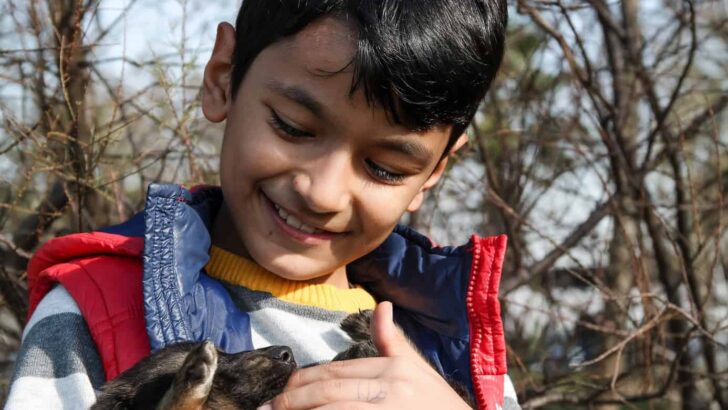- The 10 Best No-Jump Dog Harnesses For Inspired Dogs - July 16, 2022
- Cheaper Alternative to Blue Buffalo Dog Food - July 15, 2022
- Healing From Within: The Best Dog Foods for Hypothyroidism - January 9, 2022
If you take your dog many places there are going to be situations when others are curious or friendly with your pooch. Children are often the most curious and the most inexperienced when it comes to good etiquette around dogs they don’t know. As a dog parent, you can make interactions a lot easier. Scout has out together some advice on helping facilitate healthy, fun, and rewarding interactions between kids and dogs. The most important rule to remember is to be calm, soothing, and always have your dog under control. The other most important thing is to be aware of others fears and feelings at all times.
Mastering the Basics
Before you can address any other issues, you need a firm foundation of the basics. You can think of them as the three B’s: be calm, be friendly, and be smart.
Be Calm
If a child wants to pet your dog then you need to do what you can to make sure that the interaction is calm. This means no other dogs competing for attention, and as little external stimuli as possible. If you’re in the middle of a sidewalk or a congested area, move off to the side or away from the hustle and bustle. Avoid telling the child or their parents that your dog doesn’t bite or mentioning any other negative behaviors, as it can make them suspicious that your dog might do just the opposite. It’s strange psychology, but it’s true.
If your dog isn’t accustomed to greeting children or still exhibits signs of nervousness, it might be helpful to distract your dog while a child pets them for the first time. Giving your dog a little treat or directing their eyes towards you can make it easier for a child to not be afraid to actually pet them. Eye contact with a dog can be a bit much for some kids especially if the dog is so large they can look them straight in the eye.
Be Friendly
The way you act can be sensed by not just the people around you but your dog as well. If you act friendly then your dog is more likely to do so as well. Don’t send out negative vibes to your dog! It is inevitable that someone is going to want to interact or pet your dog or ask a question about the breed you have.
Sometimes a kid will be too much for a dog to deal with. Not every child is taught how to interact with dogs and sometimes you may find yourself in a situation where their parent won’t correct their behavior. If you don’t feel comfortable gently but firmly correcting them, it is best to walk away from the situation as politely as possible. You can always say you have to get back to something or whatever is convenient. Remember, your dog will follow your lead, so it’s important to be as positive as possible. If their demeanor begins to change, it’s time to go. Learn to spot the signs that your dog is becoming overwhelmed, and make a quick exit.
Be Smart
Being smart means going out into the world well-armed with how to navigate interactions between puppy and kids. To do this, begin by starting your down on a path to socialization ASAP. When you get a puppy it is important to teach them good social manners from a young age. When dogs are smaller they are not as likely to cause major harm if they bump into a child or anything like that. It can be harder to teach older dogs how to behave. All the tips and tricks in the world can’t replace a solid foundation.
Second, always keep your dog leashed during social outings (unless in an area specifically designated as off-leash, like a park). Even the most normally well-behaved dog can get really happy and excited when socializing or meeting new people. In most areas, you are required to keep your dog on a leash when they are not on your property anyway. A leash keeps you in control of the situation and prevents your pooch from running up to meet someone too quickly. A friendly dog may not seem so friendly if someone is taken by surprise and you definitely don’t want someone falling because they are startled.
Keeping your dog leashed during social outings can also help you avoid sensory overload, like encountering too many kids at once. A few kids interacting with your dog is one thing but a big group might actually be a bit too much for your dog. This totally depends on the dog and how well behaved or mature the kids in question are.

Comforting Scared Kids
Sometimes kids have been in a scary situation or a traumatic one with a dog in the past. Some may be trying to get over this fear or their parents may be encouraging them to trust dogs again. This is a delicate situation but if approached in a calm and comforting manner you can help them get over their fear.
Sometimes kids are just cautious about dogs even if they have not had a negative experience in the past. Plenty of parents without dogs in the home report that even though their child loves the idea of petting a dog, when they get to the point where the dog is touching them they run and hide behind them or have other startling reactions. These kids need a bit of coaching and that usually comes with calm and soothing supervised interactions with dogs.
Encouraging words can help but make sure your encouragement doesn’t sound like a warning that your dog may do something. It is a good idea if you pet and distract your dog while the child eases into the situation and pets them as you are petting another area of the dog. You might say something like “Aww look she/he likes you petting them” or some other words of encouragement. Having their parent pet the dog at the same time can also help.
Dealing With Dog Stereotypes
Sometimes, children may be scared of a dog based purely on a preexisting misconception.
Some dogs have a bad reputation for bites or aggressiveness. This can make parent’s and kids alike more afraid of your dog. If you have a dog that is a Pitbull or Rottweiler for example then your dog might actually scare people without meaning to at all or doing anything at all. If this seems to be the case then it is best to not try to encourage interaction. Also be aware that just startling someone and them falling can be a big deal. Scout has heard of incidents where her pitbull friend just by being on the same trail made someone scared and they fell, resulting in a lawsuit even though there was no contact with the dog.
These stereotypes are there and ignoring them doesn’t help. Even if you have the sweetest dog out there, others might not think so and it is up to you to handle the situation in a reasonable manner and be aware of how your dog is perceived at all times.
Getting Your Dog Socialized Starts With Friends and Family
Puppies need some level of socialization. Even if you have dogs because they are for your livestock you need to get them used to children. The best way to do this, of course, is to introduce them to friends and family from the time you get them home. It actually doesn’t take that much interaction to get a puppy to learn to behave in a friendly but not overly friendly way when meeting a new young person.
There are many different strategies for performing these initial introductions, and it really boils down to what makes you feel the most comfortable. We recommend taking some time to come through a couple of these resources until you find something that feels right for you:
11 Tips on How to Introduce Your Dog to New People

Service Dog Considerations
If you are a parent then it is likely that your child will see someone with a service dog at some point. On the other side if you use a service dog due to your disability then children are going to be naturally curious. Service dogs are trained to be calm and well put together generally but they can seem a bit stand offish to some because they take their job so seriously.
A good service dog is never aggressive in public situations and doesn’t allow their nose to rule their actions. This is why you see dogs that are able to walk through even the meat section of a grocery store with no problems!
If a child is interested in your dog then they may ask a lot of questions since most dogs they see are probably just pets. The concept of a working dog is a new one to a lot of kids. Allow them to pet your dog but you may want to discourage allowing them to give your dog treats. Some handlers think that treats from strangers leads to a distracted dog.
Introducing Kids to a Very Young Puppy
Very young puppies require a different level of consideration from children, and this is especially true of socialization.
Kids and puppies are cute together but it is important to realize that puppies are just learning and so are kids to guidance can go a long way for both. Here are some tips for introducing a new puppy to your kids.
1. Always be present until you see how interactions are going and you are sure that both puppy and child are getting along well.
2. Try to let the puppy go towards the child on its own rather than the child approaching it. Kids can get really excited and that can make a new puppy nervous or scared at first.
3. Involve kids with taking care of your new puppy. This allows for supervised time with the puppy where you can offer guidance to the child and the pooch. This is a good time to start teaching kids about recognizing the body language of the puppy so they know when to stop doing something or when the puppy is just uncomfortable.
4. Being consistent is very important. Children will be watching how you act and treat the puppy so it is important to offer consistent responses and to always be patient.
Making the Time
Sometimes finding the time to socialize your dog can seem hard to do. If your dog is a farm dog or lives away from a lot of neighbors it can be even harder. With so many businesses and parks being dog-friendly nowadays you may be missing out on some good opportunities to get your dog used to people. If your favorite restaurant has a patio then there is a chance they would be fine with letting you sit and eat with your well-behaved dog. The best way to properly socialize your dog is by immersion. They need to experience as many new people and new situations as possible in order to be comfortable meeting and interacting with children. There are many great strategies for achieving this, but it can also be as simple as taking your pups on daily walks around the block.
Introducing your dog to a variety of different social situations and different places will help them be well rounded and allow you to spend more time with them overall. Good dog behavior and socialization skills makes it far more likely that you will include them in a lot of different daily activities and events.
Continue reading:
12 All-Time Best Training Dog Books For Kids




